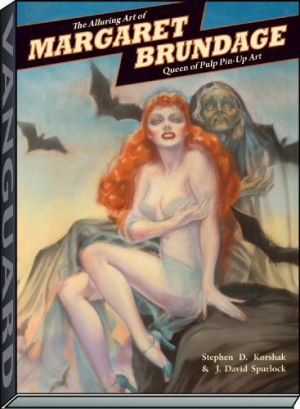The Alluring Art of Margaret Brundage
Queen of Pulp Pin-up Art
A long overdue, honest, and unbiased appraisal of Margaret Brundage’s contributions to fantasy illustration and the arts.
For the better part of a century, the specifics of the life, times, and work of Margaret Brundage have been mired in mystery and obscured by baseless speculation. This state of affairs has persisted despite the fact that this pioneering artist—whose lush pastels of scantily clad and nude women graced the cover of the seminal magazine of fantastic fiction, Weird Tales—was interviewed by several aficionados of the medium in the later years of her life.
Thankfully, we now have Stephen D. Korshak and J. David Spurlock’s The Alluring Art of Margaret Brundage: The Queen of Pulp Pin-Up Art to act as a corrective.
Korshak and Spurlock have gathered together the most extensive collection of Brundage-related essays, interviews, and art ever published in one volume. Along with those aforementioned interviews, the essays touch on topics as diverse as the sociopolitical nature of the Chicago neighborhoods frequented by Brundage; her husband and their fellow travelers; an appreciation of the artist’s work first published in Playboy; and fans’ personal reminiscences of discovering the artist’s work. These pages, which are filled with a variety of reproductions of art, vintage photographs, and other artifacts, are followed by a gallery reproducing, one to a page, the sixty-six covers Brundage created for Weird Tales and its sister magazines between 1932 and 1945.
Yet, as informative and evocative as those preceding pages might be, the heart of this book truly resides in Spurlock’s extended essay exploring “The Secret Life of Margaret Brundage.” Profusely illustrated, Spurlock’s wide-ranging biographical sketch combines solid research with thoughtful interpretation rooted in both historical fact and human nature. This approach allows him to effectively strip away the accumulated layers of misinformation, misconception, and just plain outlandish assumption concerning Brundage and her work to reveal a more balanced and informed view of his subject.
What emerges is a portrait of an artist who was not only one of the most popular illustrators of her age but also someone who was socially conscious, fully engaged, and actively working to overcome social and racial inequalities. We are finally allowed to see Brundage as a whole person, as an artist who was a woman both of, and far ahead of, her time.
Ultimately, this volume dispels the prejudicial framework that has marginalized Brundage and her work, and it encourages a long-overdue honest and unbiased appraisal of her contributions to fantasy illustration and the arts in general.
Reviewed by
Bill Baker
Disclosure: This article is not an endorsement, but a review. The publisher of this book provided free copies of the book to have their book reviewed by a professional reviewer. No fee was paid by the publisher for this review. Foreword Reviews only recommends books that we love. Foreword Magazine, Inc. is disclosing this in accordance with the Federal Trade Commission’s 16 CFR, Part 255.

